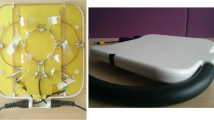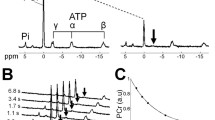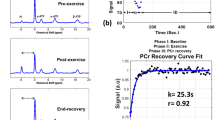Abstract
Investigation of phosphorus (31P) magnetic resonance spectroscopy under stress conditions provides a non-invasive tool to examine alterations in cardiac high-energy phosphate metabolism that may not be evident at rest. Our aim was to establish cardiac 31P MR spectroscopy during leg exercise at 3T. The increased field strength should provide a higher signal to noise ratio than at lower field strengths. Furthermore, relatively high temporal resolution at a sufficiently fine spatial resolution should be feasible. 31P MR spectra were obtained with a 3D acquisition weighted chemical shift imaging sequence in 20 healthy volunteers at rest, during dynamic physiological leg exercise and after recovery at 3T. Haemodynamic measurements were made throughout and the rate pressure product calculated. With exercise, the mean heart rate increased by 73%, achieving a mean increase in rate pressure product of 115%. The corrected PCr/ATP ratio for subjects at rest was 2.02 ± 0.43, exercise 2.14 ± 0.67 (P = 0.54 vs. rest) and at recovery 2.03 ± 0.52 (P = 0.91 vs. rest, P = 0.62 vs. exercise). A cardiac 31P MR spectroscopy physiological exercise-recovery protocol is feasible at 3T. There was no significant change in high-energy cardiac phosphate metabolite concentrations in healthy volunteers at rest, during physiological leg exercise or during recovery. When applied to patients with heart disease, this protocol should provide insights into physiological and pathological cardiac metabolism.



Similar content being viewed by others
References
Neubauer S, Krahe T, Schindler R et al (1992) 31P magnetic resonance spectroscopy in dilated cardiomyopathy and coronary artery disease. Altered cardiac high-energy phosphate metabolism in heart failure. Circulation 86(6):1810–1818
Scheuermann-Freestone M, Madsen PL, Manners D et al (2003) Abnormal cardiac and skeletal muscle energy metabolism in patients with type 2 diabetes. Circulation 107(24):3040–3046
Lamb HJ, Beyerbacht HP, van der Laarse A et al (1999) Diastolic dysfunction in hypertensive heart disease is associated with altered myocardial metabolism. Circulation 99(17):2261–2267
Crilley JG, Boehm EA, Blair E et al (2003) Hypertrophic cardiomyopathy due to sarcomeric gene mutations is characterized by impaired energy metabolism irrespective of the degree of hypertrophy. J Am Coll Cardiol 41(10):1776–1782
Neubauer S, Horn M, Cramer M et al (1997) Myocardial phosphocreatine-to-ATP ratio is a predictor of mortality in patients with dilated cardiomyopathy. Circulation 96(7):2190–2196
Beyerbacht HP, Lamb HJ, van Der Laarse A et al (2001) Aortic valve replacement in patients with aortic valve stenosis improves myocardial metabolism and diastolic function. Radiology 219(3):637–643
Hart PE, Lodi R, Rajagopalan B et al (2005) Antioxidant treatment of patients with Friedreich ataxia: four-year follow-up. Arch Neurol 62(4):621–626
Beer M, Wagner D, Myers J et al (2008) Effects of exercise training on myocardial energy metabolism and ventricular function assessed by quantitative phosphorus-31 magnetic resonance spectroscopy and magnetic resonance imaging in dilated cardiomyopathy. J Am Coll Cardiol 51(19):1883–1891. doi:10.1016/j.jacc.2007.09.075
Bache RJ, Zhang J, Path G et al (1994) High-energy phosphate responses to tachycardia and inotropic stimulation in left ventricular hypertrophy. Am J Physiol 266(5 Pt 2):H1959–H1970
Weiss RG, Bottomley PA, Hardy CJ et al (1990) Regional myocardial metabolism of high-energy phosphates during isometric exercise in patients with coronary artery disease. N Engl J Med 323(23):1593–1600
Kuno S, Ogawa T, Katsuta S et al (1994) In vivo human myocardial metabolism during aerobic exercise by phosphorus-31 nuclear magnetic resonance spectroscopy. Eur J Appl Physiol Occup Physiol 69(6):488–491
Buchthal SD, den Hollander JA, Merz CN et al (2000) Abnormal myocardial phosphorus-31 nuclear magnetic resonance spectroscopy in women with chest pain but normal coronary angiograms. N Engl J Med 342(12):829–835
Pluim BM, Lamb HJ, Kayser HW et al (1998) Functional and metabolic evaluation of the athlete’s heart by magnetic resonance imaging and dobutamine stress magnetic resonance spectroscopy. Circulation 97(7):666–672
Yabe T, Mitsunami K, Okada M et al (1994) Detection of myocardial ischemia by 31P magnetic resonance spectroscopy during handgrip exercise. Circulation 89(4):1709–1716
Evanochko WT, Buchthal SD, den Hollander JA et al (2002) Cardiac transplant patients response to the (31)P MRS stress test. J Heart Lung Transplant 21(5):522–529
Lamb HJ, Beyerbacht HP, Ouwerkerk R et al (1997) Metabolic response of normal human myocardium to high-dose atropine-dobutamine stress studied by 31P-MRS. Circulation 96(9):2969–2977
Schaefer S, Schwartz GG, Steinman SK et al (1992) Metabolic response of the human heart to inotropic stimulation: in vivo phosphorus-31 studies of normal and cardiomyopathic myocardium. Magn Reson Med 25(2):260–272
Tsutsui JM, Elhendy A, Xie F et al (2005) Safety of dobutamine stress real-time myocardial contrast echocardiography. J Am Coll Cardiol 45(8):1235–1242
Conway MA, Bristow JD, Blackledge MJ et al (1991) Cardiac metabolism during exercise in healthy volunteers measured by 31P magnetic resonance spectroscopy. Br Heart J 65(1):25–30
Conway MA, Bristow JD, Blackledge MJ et al (1988) Cardiac metabolism during exercise measured by magnetic resonance spectroscopy. Lancet 2(8612):692
Hetherington HP, Luney DJ, Vaughan JT et al (1995) 3D 31P spectroscopic imaging of the human heart at 4.1T. Magn Reson Med 33(3):427–431
Menon RS, Hendrich K, Hu X et al (1992) 31P NMR spectroscopy of the human heart at 4T: detection of substantially uncontaminated cardiac spectra and differentiation of subepicardium and subendocardium. Magn Reson Med 26(2):368–376
Tyler DJ, Hudsmith LE, Clarke K et al. (2008) A comparison of cardiac (31)P MRS at 1.5 and 3T. NMR Biomed. doi: 10.1002/nbm.1255
Tyler DJ, Emmanuel Y, Cochlin LE et al. (2008) Reproducibility of (31)P cardiac magnetic resonance spectroscopy at 3T. NMR Biomed. doi: 10.1002/nbm.1350
Bottomley PA, Hardy CJ (1992) Mapping of creatine kinase reaction rates in human brain and heart with 4 Tesla saturation transfer 31P NMR. J Magn Reson 99(2):443–448
Poldermans D, Fioretti PM, Boersma E et al (1994) Safety of dobutamine-atropine stress echocardiography in patients with suspected or proven coronary artery disease. Am J Cardiol 73(7):456–459
Navare SM, Katten D, Johnson LL et al (2006) Risk stratification with electrocardiographic-gated dobutamine stress technetium-99 m sestamibi single-photon emission tomographic imaging: value of heart rate response and assessment of left ventricular function. J Am Coll Cardiol 47(4):781–788
Gobel FL, Norstrom LA, Nelson RR et al (1978) The rate-pressure product as an index of myocardial oxygen consumption during exercise in patients with angina pectoris. Circulation 57(3):549–556
Naressi A, Couturier C, Castang I et al (2001) Java-based graphical user interface for MRUI, a software package for quantitation of in vivo/medical magnetic resonance spectroscopy signals. Comput Biol Med 31(4):269–286
Tyler DJ, Hudsmith LE, Neubauer S, Clarke K, Robson MD (2006) Comparison of Cardiac Phosphorus Spectroscopy at 1.5T and 3T. ISMRM, Seattle, USA. John Wiley and Sons
Bottomley PA, Ouwerkerk R (1994) Optimum flip-angles for exciting NMR with uncertain T1 values. Magn Reson Med 32(1):137–141
Wikman-Coffelt J, Sievers R, Coffelt RJ et al (1983) The cardiac cycle: regulation and energy oscillations. Am J Physiol 245(2):H354–H362
Sundstedt M, Jonason T, Ahren T et al (2003) Left ventricular volume changes during supine exercise in young endurance athletes. Acta Physiol Scand 177(4):467–472
Acknowledgments
This study was supported by grants from The Medical Research Council (DJT, MDR, SN), The British Heart Foundation (LEH, DJT, YE, SEP, MDR, HW, KC, SN) and The Wellcome Trust (SN, MDR). This work was supported by the Oxford Partnership Comprehensive Biomedical Research Centre with funding from the Department of Health’s NIHR Biomedical Research Centres funding scheme.
Author information
Authors and Affiliations
Corresponding author
Additional information
Lucy E. Hudsmith and Damian J. Tyler contributed equally.
Rights and permissions
About this article
Cite this article
Hudsmith, L.E., Tyler, D.J., Emmanuel, Y. et al. 31P cardiac magnetic resonance spectroscopy during leg exercise at 3 Tesla. Int J Cardiovasc Imaging 25, 819–826 (2009). https://doi.org/10.1007/s10554-009-9492-8
Received:
Accepted:
Published:
Issue Date:
DOI: https://doi.org/10.1007/s10554-009-9492-8




